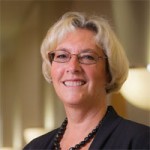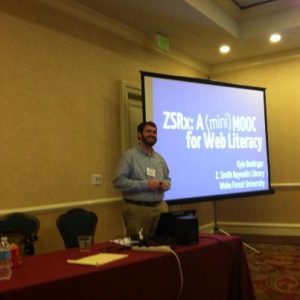This article is more than 5 years old.
First off, Kyle was magnificent. I asked him to give a presentation on our groundbreaking ZSRx mini-MOOC course at the Coalition for Networked Information meeting in San Antonio, April 4-5, knowing that we were only half-way through implementation. He graciously agreed and gave a wonderful presentation on how he built the course. I will let him tell you more about that!
I like to go to CNI because it keeps me up to date on leading edge developments in the overlapping worlds of IT and libraries. They love to be the place where things are first announced, which is why I wanted us to do ZSRx here. Even when I sit through a very technical presentation that is way over my head (like the keynote here), a bit of it seeps into my consciousness and my world is broadened just a little. Besides, I get almost all of my good ideas while at library meetings away from home and I got a couple at this one (scary, I know, and you know who you are).
The first session after the keynote was on the new library at NC State, entitled “The Library Building as Research Platform.” I was prepared to be impressed, but I was not prepared for the mind-blowing explosion of visualization technologies for data-driven science that is the core of the building. Their aim is to have the experience of awe open up the imagination. Their vision is for the library to serve as a technology incubator. The building is an entirely new model; there aren’t any others like it – yet. It is a world very different from Wake Forest and ZSR, but they have captured the essence of their campus perfectly. I can’t wait to see it in person and I believe we are going to try to schedule another group visit this summer when things settle down.
I attended several presentations on big storage solutions. One was a cheap, local server-farm solution, that worked for the needs in its library. Another was an almost exact replica of our Amazon cloud experience, except that we did it three years ago for all web services and this library did it just recently but only for digital scholarship projects. Their reasons were the same as ours: the need for flexibility and independence.
SUNY Buffalo talked about the results of four e-textbook pilots in which they participated this past year, some on their own and some in collaboration with other campuses. One surprising fact was that on their campus, 40% of students buy no textbooks at all because they are so expensive and students can make do without them. One pilot involved their bookstore, but they tended to be inflexible and not willing to give discounts as big as could be achieved elsewhere. They were also involved in two of the EDUCAUSE pilot programs using commercial partners. In the most successful pilot, savings of up to 87% were achieved. In the end, the conclusion seemed to be that while the pilots were promising, the world is still not quite ready for e-texts. Students in the pilot still preferred print by a large margin. The only thing they liked about the e-version was the discount. I tend to agree with their conclusion that e-textbooks will be mature when kids have grown up with them. The presenter told the story of his three-year-old standing in front of the television swiping it in an attempt to change the channel. That child will be ready for e-textbooks!
The last presentation I went to was about the IMS Global Learning Consortium, about which I knew nothing. It is a non-profit organization comprised of both commercial providers and higher education institutions. IMS is focused on the exchange of digital content. Their goal is to have standards for open content so that all systems can “just work.” Three of their main programs are Common Cartridge, Learning Tools Operability (LTI) and Learning Information Services (LIS). They are trying to move technology in higher education for student information success to break the status quo of closed proprietary systems. I will try to follow their progress in the future.
We had to catch a plane before the last plenary session on the Ithaka S+R 2012 US Faculty survey, but CNI puts up video and slides for each of its meetings, so I will put the links up when I get them. All in all, a very useful meeting!


2 Comments on ‘CNI with Lynn (and Kyle)’
I had never heard of CNI before Kyle started talking about it. It sounds like a very cool conference! I can’t wait for ZSR to make another trip to the new library at NC State!
(And way to go Kyle on your presentation at CNI! ZSRx has been amazing!)
A trip to NC State would be wonderful. And it does sound like a valuable conference, glad you are attending!